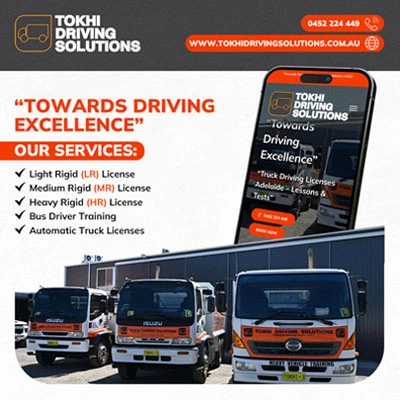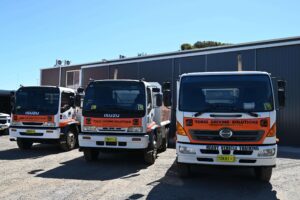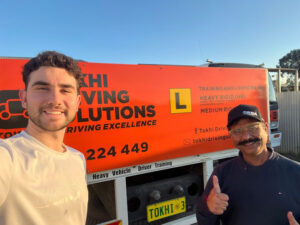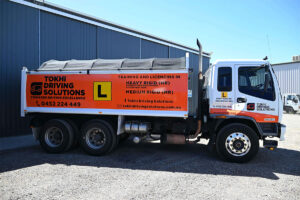Truck driving plays a vital role in Australia’s economy, ensuring the smooth movement of goods across vast distances. Whether you’re looking to drive a delivery truck in your city or a road train across the Outback, understanding the types of truck licences available in Australia is the first step toward a successful career.
At Tokhi Driving Solutions, we’re committed to helping aspire drivers navigate the truck licensing process with expert training and support.
Overview of Truck Licences in Australia
In Australia, truck licences are issued under the National Heavy Vehicle Driver Licence System, which ensures consistency across all states and territories. Each licence type determines the class of vehicle you’re allowed to operate, making it essential to choose the right one for your needs.
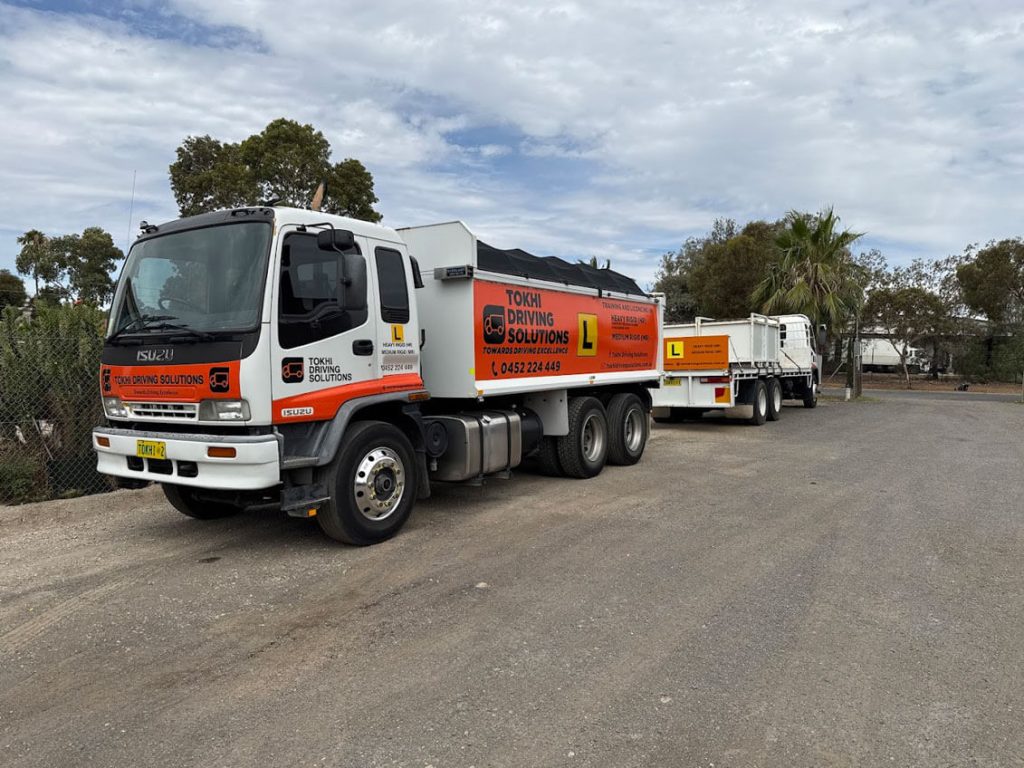
Types of Truck Licences in Australia
1. LR (Light Rigid Licence)

The LR (Light Rigid) Licence is the entry-level truck licence designed for those who wish to transition from standard passenger vehicles to larger commercial vehicles. It’s ideal for drivers aiming to operate vehicles with a Gross Vehicle Mass (GVM) between 4.5 tonnes and up to 8 tonnes. This licence offers flexibility, enabling drivers to handle a variety of vehicles, including small delivery trucks, light-duty buses, and minibuses carrying up to 12 passengers (including the driver).
The LR licence is a great starting point for those exploring careers in the transportation sector. Many new drivers use this licence as a stepping stone to gain experience with larger vehicles before progressing to more advanced truck licences. In addition to general freight, it is popular among school bus drivers and community transport operators.
To apply for this licence, drivers must hold a car (C class) licence for at least 12 months. LR licence training is readily available across Australia, with institutions offering tailored programs that teach drivers how to handle light rigid vehicles safely and confidently.
- Eligibility: Must have held a car (C class) licence for at least 12 months.
- Examples of Vehicles: Small delivery trucks, minibuses with up to 12 passengers.
- Job Opportunities: School bus drivers, community transport operators, small freight delivery.
2. MR (Medium Rigid Licence)

The MR (Medium Rigid) Licence is designed for drivers ready to handle larger and heavier vehicles. It permits the operation of trucks and buses with a GVM over 8 tonnes but restricted to two axles. This includes a wide range of medium-duty vehicles, such as larger courier trucks and furniture removalist vehicles.
The MR licence is an excellent choice for those looking to expand their driving skills and access better job opportunities in industries like logistics and public transportation. This licence also allows for towing trailers up to 9 tonnes, making it suitable for individuals who need more versatility in their work.
To qualify, applicants must hold a C class licence for at least 12 months. Training programs for MR licences cover advanced driving techniques, vehicle maintenance, and road safety to prepare drivers for the challenges of operating medium rigid vehicles.
- Eligibility: Must have held a car (C class) licence for at least 12 months.
- Examples of Vehicles: Furniture removal trucks, larger courier vehicles, small buses.
- Job Opportunities: Public transport drivers, furniture removalists, medium-scale freight delivery.
3. HR (Heavy Rigid Licence)

The HR (Heavy Rigid) Licence is a versatile and widely sought-after licence in the trucking industry. It authorises drivers to operate trucks or buses with three or more axles, making it suitable for a variety of vehicles, including articulated buses, tipper trucks, and heavy-duty freight vehicles.
The HR licence is ideal for drivers pursuing careers in public transportation or logistics. It is also a common requirement for roles in the mining and construction sectors, where heavy vehicles are integral to daily operations. The licence allows for towing trailers up to 9 tonnes, providing flexibility for various job demands.
To be eligible, drivers must have held a car (C class) licence for at least two years. The HR licence is often considered a gateway to higher levels of truck driving and is a prerequisite for obtaining HC (Heavy Combination) and MC (Multi-Combination) licences.
- Eligibility: Must have held a car (C class) licence for at least two years.
- Examples of Vehicles: Articulated buses, heavy freight trucks, tipper trucks.
- Job Opportunities: Bus drivers, interstate freight operators, mining and construction drivers.
4. HC (Heavy Combination Licence)

The HC (Heavy Combination) Licence is an advanced licence for experienced drivers looking to operate articulated vehicles, such as prime movers with single trailers. This licence is ideal for individuals pursuing careers in long-haul freight and specialised logistics operations.
HC licence holders are qualified to drive semi-trailers and rigid trucks towing trailers over 9 tonnes. This makes them valuable assets in industries requiring the transport of heavy goods, such as fuel, construction materials, and refrigerated products.
To apply, drivers must have held either an MR or HR licence for at least 12 months. HC licence training focuses on mastering complex vehicle handling, including reversing articulated trucks and understanding load distribution.
- Eligibility: Must have held an MR or HR licence for at least 12 months.
- Examples of Vehicles: Semi-trailers, rigid trucks towing trailers, fuel tankers.
- Job Opportunities: Long-haul freight drivers, specialised logistics operators.
5. MC (Multi-Combination Licence)

The MC (Multi-Combination) Licence is the highest level of truck licensing in Australia, designed for the most skilled drivers. It allows operation of the largest and most complex vehicles, including B-doubles, road trains, and any HC-class vehicle with multiple trailers.
MC licence holders are in high demand across industries requiring bulk transport of goods over long distances. This includes mining, agriculture, and interstate logistics. Drivers must undergo rigorous training to qualify, ensuring they are equipped to handle the unique challenges of operating multi-combination vehicles.
- Eligibility: Must have held an HC licence for at least 12 months and complete advanced training for MC operation.
- Examples of Vehicles: Road trains, B-doubles, bulk transport vehicles.
- Job Opportunities: Interstate freight drivers, mining logistics, agricultural transport.
How to Choose the Right Truck Licence for Your Career
Choosing the correct licence depends on your career goals and the type of vehicle you wish to operate. For instance:
- If you aim to work in local deliveries, an LR or MR licence may suffice.
- For interstate freight, consider an HC or MC licence.
- Some industries, such as mining, require specialised training alongside specific licences.
Steps to Obtain a Truck Licence in Australia
- Meet Eligibility Requirements
- Be at least 18 years old.
- Hold the prerequisite licence for the required period.
- Pass a medical fitness test.
- Complete Training
Enrol in an accredited training program, like those offered by Tokhi Driving Solutions, to build the necessary skills and knowledge. - Pass the Assessments
- Theory test covering road rules and vehicle operation.
- Practical driving test to demonstrate competency.
- Upgrade Your Licence
With experience, you can upgrade to higher licence classes for expanded career opportunities.
Benefits of Having a Truck Licence
Truck driving in Australia offers:
- Job Security: With Australia’s growing logistics industry, there’s always demand for skilled drivers.
- Attractive Salaries: Drivers with MC licences can earn upwards of $120,000 per year, depending on the role (source).
- Flexibility: Choose between local, interstate, or specialised roles.
Why Choose Tokhi Driving Solutions?
At Tokhi Driving Solutions, we provide:
- Comprehensive training for all licence classes.
- Experienced instructors with industry insights.
- Support for passing theory and practical tests on your first attempt.
Our programs are designed to help you build confidence and expertise, ensuring a smooth start to your trucking career.
Frequently Asked Questions (FAQs)
1. How much does it cost to get a truck licence in Australia?
The cost varies by state and licence type but generally ranges from $800 to $3,000, including training and testing fees.
2. Can I upgrade my truck licence?
Yes, you can upgrade by meeting the eligibility and experience requirements for the next class.
3. Do I need a truck licence to drive a motorhome?
Not always. If the motorhome’s GVM exceeds 4.5 tonnes, you’ll need an LR or higher licence.
Conclusion
Truck driving is a rewarding and in-demand career in Australia. Whether you’re just starting or looking to advance your skills, Tokhi Driving Solutions can help you achieve your goals.
Ready to start your trucking career? Contact Tokhi Driving Solutions today for professional training and guidance.


